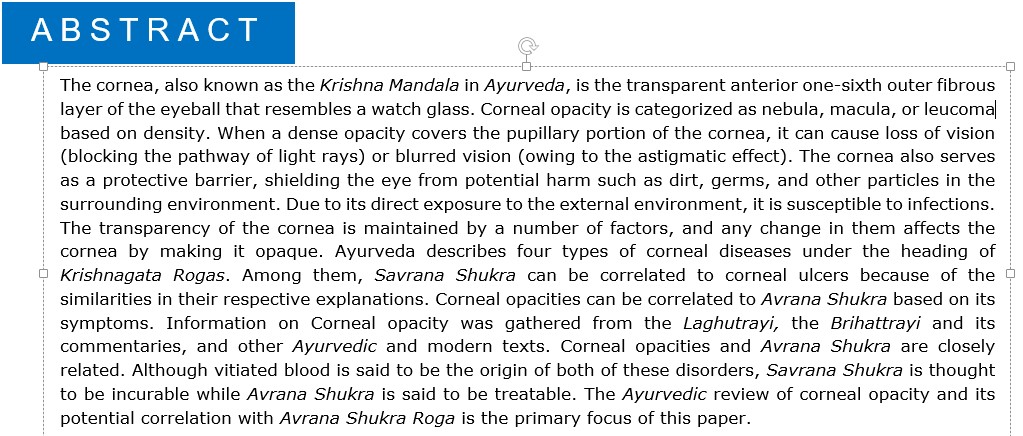Understanding Corneal Opacity in Ayurveda perspectives
DOI:
https://doi.org/10.21760/jaims.9.6.37Keywords:
Cornea, Corneal opacity, Avrana Shukra, Savrana ShukraAbstract
The cornea, also known as the Krishna Mandala in Ayurveda, is the transparent anterior one-sixth outer fibrous layer of the eyeball that resembles a watch glass. Corneal opacity is categorized as nebula, macula, or leucoma based on density. When a dense opacity covers the pupillary portion of the cornea, it can cause loss of vision (blocking the pathway of light rays) or blurred vision (owing to the astigmatic effect). The cornea also serves as a protective barrier, shielding the eye from potential harm such as dirt, germs, and other particles in the surrounding environment. Due to its direct exposure to the external environment, it is susceptible to infections. The transparency of the cornea is maintained by a number of factors, and any change in them affects the cornea by making it opaque. Ayurveda describes four types of corneal diseases under the heading of Krishnagata Rogas. Among them, Savrana Shukra can be correlated to corneal ulcers because of the similarities in their respective explanations. Corneal opacities can be correlated to Avrana Shukra based on its symptoms. Information on Corneal opacity was gathered from the Laghutrayi, the Brihattrayi and its commentaries, and other Ayurvedic and modern texts. Corneal opacities and Avrana Shukra are closely related. Although vitiated blood is said to be the origin of both of these disorders, Savrana Shukra is thought to be incurable while Avrana Shukra is said to be treatable. The Ayurvedic review of corneal opacity and its potential correlation with Avrana Shukra Roga is the primary focus of this paper.
Downloads
References
Shastri Ambikadutta, Sushrutha Samhita of Sushrutha, Edited with Ayurveda tattva sandipika hindi commentary, Uttar Tantra, Chapter no- 1/13, Chaukhambha Sanskrit Sansthan, Varanasi, Reprint 2016, Part-2, P. No.7
Shastri Ambikadutta, Sushrutha Samhita of Sushrutha, Edited with Ayurveda tattva sandipika hindi commentary, Uttar Tantra, Chapter no- 1/13, Chaukhambha Sanskrit Sansthan, Varanasi, Reprint 2016, Part-2, P. No.7
Shastri Ambikadutta, Sushrutha Samhita of Sushrutha, Edited with Ayurveda tattva sandipika hindi commentary, Uttar Tantra, Chapter no- 1/44, Chaukhambha Sanskrit Sansthan, Varanasi, Reprint 2016, Part-2, P. No.17
Brahmanand Tripathi, Astanga Hridayam of Vagbhata, Uttara Sthana Chapter no.- 10/22-28, Edited with Nirmala Hindi Commentary, Chaukhambha Sanskrit Pratishthan, Delhi, Edition: Reprint, 2019, P.No.- 951.
Gupta, N., Tandon, R., Gupta, S. K., Sreenivas, V., & Vashist, P. (2013). Burden of corneal blindness in India. Indian journal of community medicine: official publication of Indian Association of Preventive & Social Medicine, 38(4), 198–206. https://doi.org/10.4103/0970-0218.120153]
Shastri Ambikadutta, Sushrutha Samhita of Sushrutha, Edited with Ayurveda tattva sandipika hindi commentary, Uttar Tantra, Chapter no- 5/8, Chaukhambha Sanskrit Sansthan, Varanasi, Reprint 2016, Part-2, P. No.32.
Whitcher JP, Srinivasan M, Upadhyay MP. Corneal blindness: a global perspective. Bull World Health Organ. 2001; 79: 214–221.
https://uvahealth.com/services/eye-care/corneal-opacity
Shastri Ambikadutta, Sushrutha Samhita of Sushrutha, Edited with Ayurveda tattva sandipika hindi commentary, Uttar Tantra, Chapter no- 5/4, Chaukhambha Sanskrit Sansthan, Varanasi, Reprint 2016, Part-2, P. No.29
Shastri Ambikadutta, Sushrutha Samhita of Sushrutha, Edited with Ayurveda tattva sandipika hindi commentary, Uttar Tantra, Chapter no- 5/9, Chaukhambha Sanskrit Sansthan, Varanasi, Reprint 2016, Part-2, P. No.32.
Shastri Ambikadutta, Sushrutha Samhita of Sushrutha, Edited with Ayurveda tattva sandipika hindi commentary, Uttar Tantra, Chapter no- 5/10, Chaukhambha Sanskrit Sansthan, Varanasi, Reprint 2016, Part-2, P. No.32.
Brahmanand Tripathi, Astanga Hridayam of Vagbhata, Uttara Sthana Chapter no.- 10/27, Edited with Nirmala Hindi Commentary, Chaukhambha Sanskrit Pratishthan, Delhi, Edition: Reprint, 2019, P.No.- 950-51
Shastri Ambikadutta, Sushrutha Samhita of Sushrutha, Edited with Ayurveda tattva sandipika hindi commentary, Uttar Tantra, Chapter no- 5/8, Chaukhambha Sanskrit Sansthan, Varanasi, Reprint 2016, Part-2, P. No.32.
Kaviraj Atridev Gupta, Ashtang Sangraha, Uttartantra 13/26 by Vagbhata, Varanasi, Choukhamba Krishandas Academy, 2005, P-234.
Vaidya Yadavji Trikamji and Narayan Ram Acharya, Sushruta Samhita Uttartantra 5/8, By Sushruta with Nibandhasngraha Commentry of Shri Dalhanacharya, Varanasi, Choukhamba Surbharti Prakashan, 2012, P-602.
Madhav Nidanam of Shri Madhavakara, Madhukosha Sanskrit Commentary by Shrivijayarakshita and Shrikanthadatta with The Vidyotini hindi commentary and notes by Sri Sudarsana sashtri, revised & edited by prof. Yadunandana Upadhyaya, part II, Chapter 59/25, reprint edition, 2014. chaukhambha Prakashan, Varanasi, p.no.333-34.
Shastri Ambikadutta, Sushrutha Samhita of Sushrutha, Edited with Ayurveda tattva sandipika hindi commentary, Uttar Tantra, Chapter no- 5/8, Chaukhambha Sanskrit Sansthan, Varanasi, Reprint 2016, Part-2, P. No.32.
Brahmanand Tripathi, Astanga Hridayam of Vagbhata, Uttara Sthana Chapter no.- 10/25, Edited with Nirmala Hindi Commentary, Chaukhambha Sanskrit Pratishthan, Delhi, Edition: Reprint, 2019, P.No.- 950.
Shastri Ambikadutta, Sushrutha Samhita of Sushrutha, Edited with Ayurveda tattva sandipika hindi commentary, Uttar Tantra, Chapter no- 5/8, Chaukhambha Sanskrit Sansthan, Varanasi, Reprint 2016, Part-2, P. No.32.
Madhav Nidanam of Shri Madhavakara, Madhukosha Sanskrit Commentary by Shrivijayarakshita and Shrikanthadatta with The Vidyotini hindi commentary and notes by Sri Sudarsana sashtri, revised & edited by prof. Yadunandana Upadhyaya, part II, Chapter 59/25, reprint edition, 2014. chaukhambha Prakashan, Varanasi, p.no.333-34















